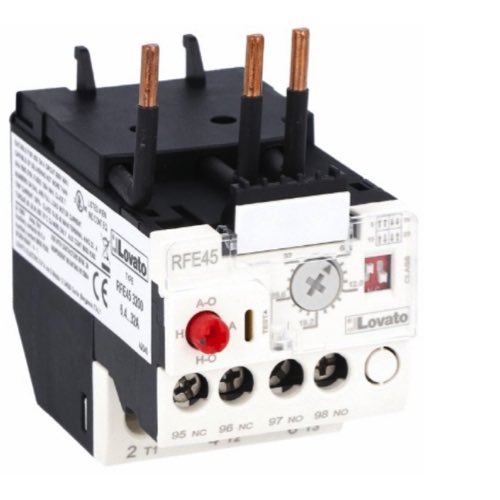
Lovato Starter Overload Relays

Lovato overload relays are designed to protect electric motors. They do so by detecting and responding in a timely manner to overcurrents and to conditions that describe a failure in one or more phases. They are good for use with both single-phase and three-phase motors because they include good protection—even more so if you use Lovato contactors with the relays—for reliable performance during "momentary faults" (a problem that sometimes occurs in industrial settings). The relays offer a motor control solution that makes for a safer electrical system.
The Lovato overload relays come in two types: manual and automatic. You can use either one of them for motor protection. For basic applications where the user doesn't want to get involved in the protection settings, the overload relay comes pre-configured in a way that it will work right out of the box and provide the simplest solution to your problem. The minimum amount of user interfaces was the basic design principle behind the Lovato overload relay.
Products
Motor Control Basics
Motor control allows operational control of electrical motors in various environments.
Motor control circuits provide a safe way to operate electrical motors. Back when motor control circuits were in their infancy, it would have been common to see a simple disconnect switch that would be used to turn on and off a motor. Depending on the size of the motor and how much voltage was required, operating this disconnect would have been dangerous, with a very high possibility of arcing or electrocution. Not to mention that when the disconnect was actuated, the large amount of inrush current would have damaged the motor over time.
In today's motor control circuits, there are a few common pieces of hardware.
A circuit breaker is used to protect the motor and any hardware downstream. A contactor and an overload relay are connected together and function in tandem to allow for remote and safe operation of the motor. The contactor functions much like a relay, allowing for a smaller electrical circuit to remotely close the motor contacts, starting the motor. The overload relay is designed to protect the motor in the case of a prolonged overcurrent event. These two devices are wired in series, so that if the overload relay detects an overcurrent event, the contactor will open the motor contacts, shutting off power to the motor.
The other two most common types of motor control hardware are a soft starter and a Variable Frequency Drive (VFD).
Both of these devices function in a similar way to the motor circuit with some added functions. The soft starter is designed to reduce large inrush current to the motor upon startup. This “soft starting” of the motor will prolong its life and allow for safer operation. The VFD performs the soft start functions, but also allows for speed control of the motor. This speed control is critical in many different environments and has made VFDs one of the most common and safe to use motor control circuits today.

